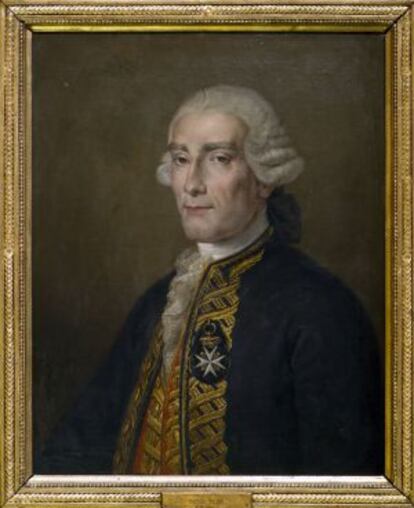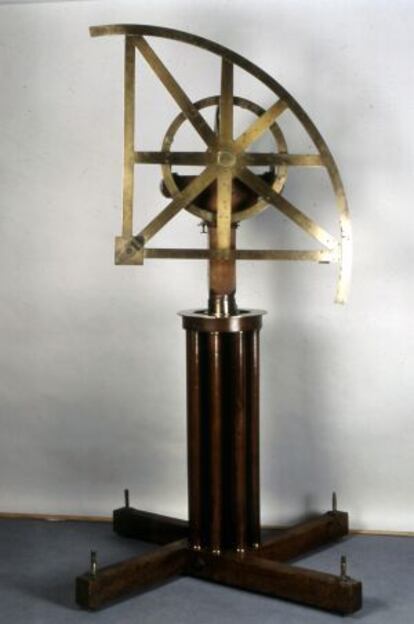Journey to the girth of the Earth
Three hundred years after his birth, the figure of Jorge Juan is being revived The scientist, sailor, engineer, chronicler and "wise Spaniard" condemned slavery in the Americas


Three hundred years ago scientists used to argue over the exact shape of the Earth with the same passion with which they recently debated the plasticity of the brain.
One of the first people to have irrefutable proof of the precise girth of the globe was Jorge Juan y Santalices (1713-1773), who no sooner after graduating as a midshipman took the opportunity to set sail on a historic mission to prove it. Now, 300 years after his birth, institutions such as the Naval Museum in Madrid and the Miguel de Cervantes Virtual Library are recovering the legacy of a man who, despite in his day being known around Europe as the "the wise Spaniard," has only been saved from complete obscurity by having a famous Madrid street named after him.
Juan went as a spy to Britain to discover naval construction techniques
Jorge Juan was a renaissance man of the 18th century: a scientist, sailor, engineer, astronomer, chronicler, mathematician and a spy at the service of the King of Spain. Admitted into Europe's most important science academies, he condemned the slavery of the Amerindians and mixed science and adventure with skill. Little-known documents preserved in the Naval Museum Archive shed light on his espionage mission to Britain to discover naval construction techniques and to secretly recruit dozens of British workers to develop new ships in Spain. He was a staunch defender of the British models over the French, which prevailed in the Spanish Navy, and just before he died he wrote a secret letter to the king to warn him of the danger that design entailed. Some experts, says Naval Museum Archive chief Pilar del Campo, believe the French model was one of the factors contributing to the Spanish naval disaster at the Battle of Trafalgar in 1805.

At the start of the 18th century, a huge row was raging among academics over the shape of the Earth. The British defended Isaac Newton and the French defended astronomer Giovanni Domenico Cassini. To resolve the dispute, the Royal Academy of Sciences in Paris organized two expeditions - one to the north of Europe and another to the equator, under Spanish command - with the aim of taking measurements.
When Juan and Ulloa reached Spain they were leading lights of the science world
On May 26, 1735 Juan and fellow Spaniard Antonio de Ulloa set sail from C¨¢diz with a public mandate to uncover scientific data and a secret one to obtain political, military and social information. Ten years later they returned, miraculously, having faced unpredictable adventures, certain danger and horrible tasks. The French astronomer Charles Marie de La Condamine hogged all the glory that came with the success of the expedition - the mission went down in history under his name - pushing out not only the two Spaniards, but also his French colleague Louis Godin.

Nevertheless, when Juan and Ulloa set foot on Spanish shores once again, they were leading lights of the science world - their mission also fixed the line dividing Spanish and Portuguese territory, imprecise until then - as well as two straight-talking chroniclers. In a voluminous report, which they titled Memories of Peru and Chile and compiled under instructions from the Marquis de la Ensenada, they condemned abuses by magistrates and Spanish priests in the New World. Presented to King Ferdinand VI with the aim of reforming the viceroyship, the text was first published in London, in 1826, under the title Secret News of America, prior to its release in Spain. The report was the result of years of near-journalistic fieldwork for which Juan and Ulloa interviewed a multitude of sources and also included details of ports, arsenals and troops, as well as smuggling routes and tax fraud.
To them, the greed they witnessed was the mother of all evils: "The tyranny experienced by the Amerindians is born out of the insatiable hunger for riches that those who go to govern them bring to the Indies," reads their text, which is now preserved at the Naval Museum.
Tu suscripci¨®n se est¨¢ usando en otro dispositivo
?Quieres a?adir otro usuario a tu suscripci¨®n?
Si contin¨²as leyendo en este dispositivo, no se podr¨¢ leer en el otro.
FlechaTu suscripci¨®n se est¨¢ usando en otro dispositivo y solo puedes acceder a EL PA?S desde un dispositivo a la vez.
Si quieres compartir tu cuenta, cambia tu suscripci¨®n a la modalidad Premium, as¨ª podr¨¢s a?adir otro usuario. Cada uno acceder¨¢ con su propia cuenta de email, lo que os permitir¨¢ personalizar vuestra experiencia en EL PA?S.
En el caso de no saber qui¨¦n est¨¢ usando tu cuenta, te recomendamos cambiar tu contrase?a aqu¨ª.
Si decides continuar compartiendo tu cuenta, este mensaje se mostrar¨¢ en tu dispositivo y en el de la otra persona que est¨¢ usando tu cuenta de forma indefinida, afectando a tu experiencia de lectura. Puedes consultar aqu¨ª los t¨¦rminos y condiciones de la suscripci¨®n digital.








































